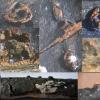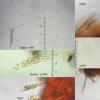
15-02-2015 14:36
Carmen EchavarriHi to allThis was found on unknowm wood (probably

14-02-2015 14:21
hannie wijersHella, I have another question.On a branch of har

14-02-2015 21:00
 Jenny Seawright
Jenny Seawright
Hello all, This Coprotus appeared on rabbit dung a

15-02-2015 11:52
Found 114-02-15, in rotten pine nuts of Pinus hale

14-02-2015 13:39
hannie wijersHello, On a branch of hardwood (which is unknown,

12-02-2015 14:58
 Björn Wergen
Björn Wergen
Hi friends,I am looking for this one:Kutorga E, Ha
Cryptovalsa protracta ?
Carmen Echavarri,
15-02-2015 14:36
This was found on unknowm wood (probably Tilia).
Estromata 1,5 mm. diameter x 0,5 high
Asci up to 186 x 10,56 µm
Spores
(7.7) 8.6 - 10.5 (11) x (1.7) 1.9 - 2.4 (2.6) px
Q = (3.5) 3.8 - 4.7 (5.4) ; N = 35
Me = 9.5 x 2.2 px ; Qe = 4.3
I think it fits with Criptovalsa protracta, but not sure and would appreciate your opinion.
Thanks in advance
Carmen echavarri
Björn Wergen,
15-02-2015 15:29

Re : Cryptovalsa protracta ?
Hi Carmen,
this is right, you should count 32 spores in the asci.
regards,
björn
this is right, you should count 32 spores in the asci.
regards,
björn
Carmen Echavarri,
15-02-2015 15:42
Re : Cryptovalsa protracta ?
Hello Björn
It is difficult to count the spores! but I think they are that number.
Thank you very much
Best regards
Carmen
It is difficult to count the spores! but I think they are that number.
Thank you very much
Best regards
Carmen



